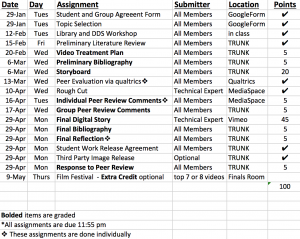Overview & Deadlines
OVERVIEW: In teams, you are required to complete an independent group project using “digital storytelling,” the use of computer-based tools to tell a story, integrating images, narrative, and music. Your goal is to use your knowledge gained from the course to become teachers and to increase your skills in environmental communication. Much of the knowledge gained in today’s world comes via multi-media, so this project forces you to think deeply on how to be scientifically accurate, accessible, and engaging. Humans are hard-wired to tell and receive stories so, if done well, your digital story has the potential to make a lasting impression.
There are many different ways of creating a digital story. Here is a professionally produced example of a digital story on shifting baselines. Here are other exemplary digital stories created by previous students. Below, this is one of the best digital stories from Environmental Biology in 2015, about kitchen pollutants.
RESOURCES: You can draw upon all course content for the digital story (e.g. lectures, readings, in-class exercises). You are required to include external resources, such as peer-reviewed journal articles, and are encouraged to consult other experts and opinions in the field. Additionally, here are more resources:
- Research Guide: Tisch Library created this guide for Environmental Biology, full of information and links to assist in finding appropriate scientific literature, images, and sounds.
- Tisch Digital Design Studio (DDS): Tisch Library’s staffed media lab with all the technological resources, including iMacs equipped with iMovie, other media editing software, and recording space.
GRADING: Your final digital storytelling project will depend upon the strength of its purpose, factual content, storytelling organization, economy of presentation, quality of images, quality of audio, citations, and copyright attribution. Please follow all instructions carefully as failure to do so will result in a grade penalty for the whole team. There are two opportunities within the project for individual grades (i.e. individual peer review comments and final reflection). We expect your digital story to not exceed 5 minutes, including citations.
The project is worth 25% of your course grade. You will be graded (100 pts total) on the following:
- Preliminary Literature Review (check)
- Video Treatment Plan (5 pts)
- Preliminary Bibliography (5 pts)
- Storyboard (20 pts)
- Individual Peer Review (5 pts)
- Group Peer Review (5 pts)
- Final Project (45 pts)
- Final Bibliography (5 pts)
- Final Reflection (5 pts)
- Response to Peer Review (5 pts)
ASSIGNMENT SUBMISSION DETAILS: Besides the videos, all assignments will be submitted online to Canvas. Each Assignment folder will specify acceptable file formats. Submit all online assignments with the following nomenclature: group number_last name_last name_last name_last name assignment title (e.g. 12_Ngo_Fanous_Smith_John_PrimaryLiteratureReview.docx)
For instructions on uploading and using MediaMarkup and Vimeo, please see the Media Markup Instructions and Vimeo Upload Instructions pages more information.
EXAMPLE DEADLINES: Meeting all deadlines is your responsibility! See the late policy
*The Film Festival will take place during finals week.
